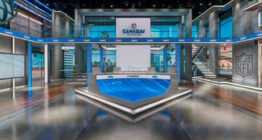Super Bowl finally fixes pesky problem of what some read as an extra ‘I’ in its numbering

Subscribe to NCS for the latest news, project case studies and product announcements in broadcast technology, creative design and engineering delivered to your inbox.
Super Bowl LVI’s logo design finally addresses what many saw as a major design flaw in the lockup that’s been around since 2015 while also making some other key changes.

That year, known as Super Bowl XLIX (which is “49” in Roman numerals), was the last year the NFL and partner broadcasters used the logo format introduced for Super Bowl XLV in 2011, which placed the trophy icon and rendering of the host stadium on top of a bar containing the words “Super Bowl.”
The Roman numerals were placed below.
For Super Bowl 50, which under the normal Roman number formatting would have been “Super Bowl L,” the NFL opted to brand the 50th game using Arabic numerals (the ones used in English and most other Western typefaces) that was finished in a gold tint.
However, the number moved to the top of the logo layout, with the trophy icon placed in the middle.
This worked fairly well when “50” numerals were used, but became problematic when the NFL went back to the Roman numerals the following year, Super Bowl LI.
In the new design, the trophy was slapped right between the “L” and “I” and, to some, looked like it read “Super Bowl LII.” Likewise, each subsequent year had a similar issue, with the trophy’s “I-like” shape inadvertently adding that glyph in the eyes of some.

2021’s Super bowl logo looked like ‘LIV’ to some, when it was really supposed to be ‘LV.’
In some cases, adding the “I” would not only change the number shown, but also might not have been correct using the rules of Roman numbering.
For what it’s worth, the Super Bowl 50 logo also had a similar issue in that it looked like “Super Bowl 510” to some.
For Super Bowl LVI, set to be played in 2022, however, the trophy has been moved behind the letter “L.”
That, and the fact that the Roman numerals become fully colorized for the first time since Super Bowl 50, removes much of the issues with having what appears to be an extra “I” added in.
The LVI logo also eliminated the heavier bevel effect used in some of the most recent years and mostly removed the colored edge accents in favor of colorizing the numerals (that color even gets a hint of reflection in the “football” that sits atop of the trophy).
It also introduces semitransparent Roman numerals, which allow for the base of the trophy icon to shine through — adjusted slightly larger to account for the “glass” lettering.
There’s also a slight diagonal line that runs along the lower part of the numerals, creating a sort of split between a deeper orange and more gold gradient.
The design also continues to practice of not including the stadium in the logo, but rather subtle outlines of palm trees, presumably a reference to the SoFi Stadium locale in Englewood, California, just outside of Los Angeles.
The location is part of a new mixed-use development that also includes the new NFL Network studios and NFL West Coast headquarters.
Super Bowl LVI is scheduled for Feb. 13, 2022.
For the first time, the NFL did not move the big game to avoid conflicting with the Olympics.
This allowed NBC, which owns the U.S. broadcast rights to the Olympics, to swap seasons with CBS so that it could air the two major sporting events together.
Instead of placing a splashy entertainment program directly following the Super Bowl like is normally done, NBC will cut right to coverage of the Olympics in Beijing.


Super Bowl LV logo in conjunction with the new CBS logo introduced in 2021.
CBS was originally scheduled to air the Super Bowl in 2022, but changed to 2021 instead (which gave it a big stage to introduce its new network logo and branding as well as new sports graphics), also positioning the network to coordinate ad deals with the NCAA Final Four tournament coverage, which it only holds rights to in odd-numbered years.
Swapping gave both networks some advantages in being able to bundle ad sales together across their respective events.
Normally Super Bowl broadcast rights rotate among NFL rights holders CBS, NBC and Fox in a set order, which was upset due to the CBS-NBC swap. As part of a new broadcast agreement, ABC will also gain a Super Bowl in 2026 for the first time since the 2005 season.
Subscribe to NCS for the latest news, project case studies and product announcements in broadcast technology, creative design and engineering delivered to your inbox.






tags
logo design, Logo Designs, super bowl, Super Bowl LVI
categories
Branding, Broadcast Industry News, Featured, Sports Broadcasting & Production